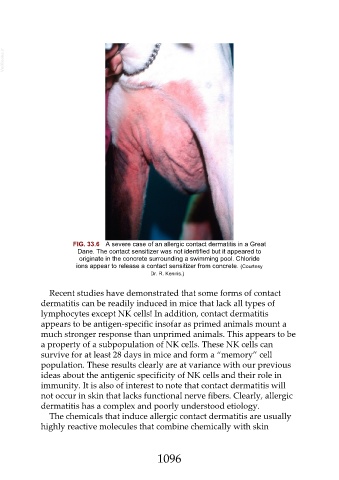Page 1096 - Veterinary Immunology, 10th Edition
P. 1096
VetBooks.ir
FIG. 33.6 A severe case of an allergic contact dermatitis in a Great
Dane. The contact sensitizer was not identified but it appeared to
originate in the concrete surrounding a swimming pool. Chloride
ions appear to release a contact sensitizer from concrete. (Courtesy
Dr. R. Kennis.)
Recent studies have demonstrated that some forms of contact
dermatitis can be readily induced in mice that lack all types of
lymphocytes except NK cells! In addition, contact dermatitis
appears to be antigen-specific insofar as primed animals mount a
much stronger response than unprimed animals. This appears to be
a property of a subpopulation of NK cells. These NK cells can
survive for at least 28 days in mice and form a “memory” cell
population. These results clearly are at variance with our previous
ideas about the antigenic specificity of NK cells and their role in
immunity. It is also of interest to note that contact dermatitis will
not occur in skin that lacks functional nerve fibers. Clearly, allergic
dermatitis has a complex and poorly understood etiology.
The chemicals that induce allergic contact dermatitis are usually
highly reactive molecules that combine chemically with skin
1096

